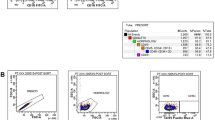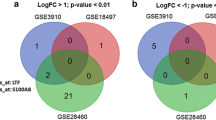Abstract
Gene expression profiling is the criterion standard for recognizing Ph-like ALL signatures among B-ALLs. The prerequisite of GEP is the accurate normalization of target genes with stable expression of housekeeping genes in a quantitative PCR. HKGs exhibit differential expression in the different experimental conditions and affect the target genes' expression, leading to imprecise qPCR results. The selection of stable HKGs is crucial in GEP experiments, especially in identifying high-risk Ph-like ALL cases. We have evaluated the expression stability of nine HKGs (GAPDH, ACTB, GUSB, RNA18S, EEF2, PGK1, B2M, TBP and ABL1) in identified Ph-like ALLs and Ph-negative (n = 23 each) using six algorithms, 4 traditional softwares; geNorm, BestKeeper, NormFinder, Delta Cq value method, and two algorithms, RefFinderTM and ComprFinder. Further, we have validated the expression of 8 overexpressed normalized genes in Ph-like ALL cases (JCHAIN, CA6, MUC4, SPATS2L, BMPR1B, CRLF2, ADGRF1 and NRXN3). GeNorm, BestKeeper, NormFinder, Delta Cq value method, RefFinderTM and ComprFinder algorithm analysis revealed that EEF2, GAPDH, and PGK1 form the best representative HKGs in Ph-like ALL cases, while RNA18s, ß-actin, and ABL1 in Ph-negative ALLs. Lastly, we performed a correlation analysis and found that the combination of EEF2, GAPDH, and PGK1 represents the best combination with a very high correlation in Ph-like ALL cases. This is the first report that shows EEF2, GAPDH, and PGK1 are the best HKG genes and can be used in the diagnostic panel of Ph-like ALL cases using qPCR at baseline diagnosis.





Similar content being viewed by others
Data availability
The data will be provided upon request, and all the data generated during this study are included in this research article.
Change history
26 August 2023
In the introduction section, reference citation has been updated from [3, 5–14, 14–21] to [3, 5–21]
References
Arber DA, Orazi A, Hasserjian R, et al. The 2016 revision to the World Health Organization classification of myeloid neoplasms and acute leukemia. Blood. 2016;127(20):2391–405. https://doi.org/10.1182/blood-2016-03-643544.
Alaggio R, Amador C, Anagnostopoulos I, et al. (2022) The 5th edition of the World Health Organization classification of Haematolymphoid tumours: Lymphoid neoplasms. Leukemia 36(7):1720–48
Roberts KG, Li Y, Payne-Turner D, et al. Targetable kinase-activating lesions in Ph-like acute lymphoblastic leukemia. N Engl J Med. 2014;371(11):1005–15. https://doi.org/10.1056/NEJMoa1403088.
Mullighan CG. The genomic landscape of acute lymphoblastic leukemia in children and young adults. Hematology Am Soc Hematol Educ Program. 2014;2014(1):174–80. https://doi.org/10.1182/asheducation-2014.1.174.
Mullighan CG, Su X, Zhang J, et al. Deletion of IKZF1 and prognosis in acute lymphoblastic leukemia. N Engl J Med. 2009;360(5):470–80. https://doi.org/10.1056/NEJMoa0808253.
Den Boer ML, van Slegtenhorst M, De Menezes RX, et al. A subtype of childhood acute lymphoblastic leukaemia with poor treatment outcome: a genome-wide classification study. Lancet Oncol. 2009;10(2):125–34. https://doi.org/10.1016/S1470-2045(08)70339-5.
Herold T, Schneider S, Metzeler KH, et al. Adults with Philadelphia chromosome-like acute lymphoblastic leukemia frequently have IGH-CRLF2 and JAK2 mutations, persistence of minimal residual disease and poor prognosis. Haematologica. 2017;102(1):130–8. https://doi.org/10.3324/haematol.2015.136366.
Heatley SL, Sadras T, Kok CH, et al. High prevalence of relapse in children with Philadelphia-like acute lymphoblastic leukemia despite risk-adapted treatment. Haematologica. 2017;102(12):e490–3. https://doi.org/10.3324/haematol.2016.162925.
Roberts KG, Reshmi SC, Harvey RC, et al. Genomic and outcome analyses of Ph-like ALL in NCI standard-risk patients: a report from the Children’s Oncology Group. Blood. 2018;132(8):815–24. https://doi.org/10.1182/blood-2018-04-841676.
Roberts KG, Gu Z, Payne-Turner D, et al. High frequency and poor outcome of philadelphia chromosome-like acute lymphoblastic leukemia in adults. J Clin Oncol. 2017;35(4):394–401. https://doi.org/10.1200/JCO.2016.69.0073.
Jain N, Roberts KG, Jabbour E, et al. Ph-like acute lymphoblastic leukemia: a high-risk subtype in adults. Blood. 2017;129(5):572–81. https://doi.org/10.1182/blood-2016-07-726588.
Reshmi SC, Harvey RC, Roberts KG, et al. Targetable kinase gene fusions in high-risk B-ALL: a study from the Children’s Oncology Group. Blood. 2017;129(25):3352–61. https://doi.org/10.1182/blood-2016-12-758979.
Chiaretti S, Gianfelici V, O’Brien SM, Mullighan CG. Advances in the genetics and therapy of acute lymphoblastic leukemia. Am Soc Clin Oncol Educ Book. 2016;35:e314–22. https://doi.org/10.14694/EDBK_156628.
Harvey RC, Kang H, Roberts KG, et al. Development and validation of a highly sensitive and specific gene expression classifier to prospectively screen and identify B-precursor acute lymphoblastic leukemia (ALL) patients with a philadelphia chromosome-like (“Ph-like” or “BCR-ABL1-Like”) signature for therapeutic targeting and clinical intervention. Blood. 2013;122(21):826–826. https://doi.org/10.1182/blood.V122.21.826.826.
Boer JM, Koenders JE, van der Holt B, et al. Expression profiling of adult acute lymphoblastic leukemia identifies a BCR-ABL1-like subgroup characterized by high non-response and relapse rates. Haematologica. 2015;100(7):e261–4. https://doi.org/10.3324/haematol.2014.117424.
Chiaretti S, Messina M, Grammatico S, et al. Rapid identification of BCR/ABL1-like acute lymphoblastic leukaemia patients using a predictive statistical model based on quantitative real time-polymerase chain reaction: clinical, prognostic and therapeutic implications. Br J Haematol. 2018;181(5):642–52. https://doi.org/10.1111/bjh.15251.
Jain S, Abraham A. BCR-ABL1-like B-acute lymphoblastic leukemia/lymphoma: a comprehensive review. Arch Pathol Lab Med. 2020;144(2):150–5. https://doi.org/10.5858/arpa.2019-0194-RA.
Chiaretti S, Messina M, Foa R. BCR/ABL1-like acute lymphoblastic leukemia: How to diagnose and treat? Cancer. 2019;125(2):194–204. https://doi.org/10.1002/cncr.31848.
Shiraz P, Payne KJ, Muffly L. The current genomic and molecular landscape of philadelphia-like acute lymphoblastic leukemia. Int J Mol Sci. 2020. https://doi.org/10.3390/ijms21062193.
Ofran Y, Izraeli S. BCR-ABL (Ph)-like acute leukemia-Pathogenesis, diagnosis and therapeutic options. Blood Rev. 2017;31(2):11–6. https://doi.org/10.1016/j.blre.2016.09.001.
Gupta DG, Varma N, Kumar A, et al. PHi-RACE: PGIMER in-house rapid and cost effective classifier for the detection of BCR-ABL1-like acute lymphoblastic leukaemia in Indian patients. Leuk Lymphoma. 2022;63(3):633–43. https://doi.org/10.1080/10428194.2021.1999439.
Tsaur G, Muhacheva T, Kovalev S, et al. Application of real-time PCR for the detection of BCR-ABL1-like group in pediatric acute lymphoblastic leukemia patients. Blood. 2018;132(Supplement 1):1376–1376. https://doi.org/10.1182/blood-2018-99-115035.
Vandesompele J, De Preter K, Pattyn F, et al. Accurate normalization of real-time quantitative RT-PCR data by geometric averaging of multiple internal control genes. Genome Biol. 2002. https://doi.org/10.1186/gb-2002-3-7-research0034.
Beillard E, Pallisgaard N, Velden V, et al. Beillard E, Pallisgaard N, van der Velden VH, Bi W, Dee R, van der Schoot E, Delabesse E, Macintyre E, Gottardi E, Saglio G, Watzinger F, Lion T, van Dongen JJ, Hokland P, Gabert JEvaluation of candidate control genes for diagnosis and residual disease detection in leukemic patients using 'real-time' quantitative reverse-transcriptase polymerase chain reaction (RQ-PCR) - a Europe Against Cancer program. Leukemia 17: 2474–2486. Leukemia : official journal of the Leukemia Society of America, Leukemia Research Fund, UK. 01/01 2004;17:2474–86. https://doi.org/10.1038/sj.leu.2403136
Lemma S, Avnet S, Salerno M, Chano T, Baldini N. Identification and validation of housekeeping genes for gene expression analysis of cancer stem cells. PLoS ONE. 2016;11(2):e0149481. https://doi.org/10.1371/journal.pone.0149481.
Silver N, Best S, Jiang J, Thein SL. Selection of housekeeping genes for gene expression studies in human reticulocytes using real-time PCR. BMC Mol Biol. 2006. https://doi.org/10.1186/1471-2199-7-33.
Villegas-Ruiz V, Olmos-Valdez K, Castro-Lopez KA, et al. Identification and validation of novel reference genes in acute lymphoblastic leukemia for droplet digital PCR. Genes (Basel). 2019. https://doi.org/10.3390/genes10050376.
Chapman JR, Waldenstrom J. With reference to reference genes: a systematic review of endogenous controls in gene expression studies. PLoS ONE. 2015;10(11):e0141853. https://doi.org/10.1371/journal.pone.0141853.
Aggarwal A, Jamwal M, Viswanathan GK, et al. Optimal reference gene selection for expression studies in human reticulocytes. J Mol Diagn. 2018;20(3):326–33. https://doi.org/10.1016/j.jmoldx.2018.01.009.
Gupta DG, Varma N, Kumar A, et al. Identification and validation of suitable housekeeping genes for gene expression studies in BCR-ABL1 positive B-lineage acute lymphoblastic leukemia. Mol Biol Rep. 2022. https://doi.org/10.1007/s11033-022-07337-w.
Pfaffl MW, Tichopad A, Prgomet C, Neuvians TP. Determination of stable housekeeping genes, differentially regulated target genes and sample integrity: BestKeeper–Excel-based tool using pair-wise correlations. Biotechnol Lett. 2004;26(6):509–15. https://doi.org/10.1023/b:bile.0000019559.84305.47.
Andersen CL, Jensen JL, Orntoft TF. Normalization of real-time quantitative reverse transcription-PCR data: a model-based variance estimation approach to identify genes suited for normalization, applied to bladder and colon cancer data sets. Cancer Res. 2004;64(15):5245–50. https://doi.org/10.1158/0008-5472.CAN-04-0496.
Xie F, Xiao P, Chen D, Xu L, Zhang B. miRDeepFinder: a miRNA analysis tool for deep sequencing of plant small RNAs. Plant Mol Biol. 2012. https://doi.org/10.1007/s11103-012-9885-2.
Zhang J, Deng C, Li J, Zhao Y. Transcriptome-based selection and validation of optimal house-keeping genes for skin research in goats (Capra hircus). BMC Genomics. 2020;21(1):493. https://doi.org/10.1186/s12864-020-06912-4.
Gupta DG, Varma N, Kumar A, et al. Genomic and Proteomic characterization of Ph-like B-lineage Acute Lymphoblastic Leukemia. A report of Indian patients: Cancer; 2022. https://doi.org/10.1002/cncr.34665.
Sharma M, Sachdeva MU, Varma N, Varma S, Marwaha RK. Characterization of immunophenotypic aberrancies in adult and childhood acute lymphoblastic leukemia: A study from Northern India. J Cancer Res Ther Apr-Jun. 2016;12(2):620–6. https://doi.org/10.4103/0973-1482.147716.
Gupta DG, Varma N, Naseem S, et al. Characterization of immunophenotypic aberrancies with respect to common fusion transcripts in B-cell precursor acute lymphoblastic leukemia: a report of 986 Indian patients. Turk J Haematol. 2022;39(1):1–12. https://doi.org/10.4274/tjh.galenos.2021.2021.0326.
Pakakasama S, Kajanachumpol S, Kanjanapongkul S, et al. Simple multiplex RT-PCR for identifying common fusion transcripts in childhood acute leukemia. Int J Lab Hematol. 2008;30(4):286–91. https://doi.org/10.1111/j.1751-553X.2007.00954.x.
Bhatia P, Binota J, Varma N, et al. Incidence of common chimeric fusion transcripts in B-cell acute lymphoblastic leukemia: an Indian perspective. Acta Haematol. 2012;128(1):17–9. https://doi.org/10.1159/000338260.
Livak KJ, Schmittgen TD. Analysis of relative gene expression data using real-time quantitative PCR and the 2(-Delta Delta C(T)) Method. Methods. 2001;25(4):402–8. https://doi.org/10.1006/meth.2001.1262.
Acknowledgements
We are highly thankful to the Department of Hematology faculty members for providing the necessary infrastructure and facilities for this research study. We also thank the Department of Paediatrics, Internal Medicine and Clinical Hematology and Medical Oncology for providing the pediatric and adult B-ALL samples. Our sincere appreciation to the clerical staff (Mr. Gurpreet) of Hematology for their valuable support and contribution to this research work.
Funding
Supported by the Post Graduate Institute of Medical Education and Research (PGIMER), Chandigarh, India (Grant INT/IEC/2019/000611; 19.03.2019).
Author information
Authors and Affiliations
Contributions
DGG and NV conceptualized and designed the experimental plan of the research study. DGG, JB, and PB performed the outlined experiments planned in the study; DGG and NV wrote and prepared the manuscript. DGG SAA, and PS, MRS, performed the statistical analysis and analyzed the generated research data. PM, AK, and SV provided the B-ALL samples in this study. All other authors read, approved, and provided the necessary intellectual comments to the submitted manuscript.
Corresponding author
Ethics declarations
Conflict of interest
None Declared.
Consent for publication
Not Applicable.
Ethics approval
Post Graduate Institute of Medical Education and Research (PGIMER) constituted Institutional Ethics Committee (IEC) approved this study (vide no. INT/IEC/2019/000611; 19.03.2019). Written consent Performa was obtained from all the enrolled patients, and all the procedures were performed according to the Helsinki Declaration 1975 (Revised 2008).
Additional information
Publisher's Note
Springer Nature remains neutral with regard to jurisdictional claims in published maps and institutional affiliations.
Supplementary Information
Below is the link to the electronic supplementary material.
Rights and permissions
Springer Nature or its licensor (e.g. a society or other partner) holds exclusive rights to this article under a publishing agreement with the author(s) or other rightsholder(s); author self-archiving of the accepted manuscript version of this article is solely governed by the terms of such publishing agreement and applicable law.
About this article
Cite this article
Gupta, D.G., Varma, N., Abdulkadir, S.A. et al. Identification and validation of the optimal reference genes for standardizing the gene expression profiling diagnostic panel of Ph-like B-lineage acute lymphoblastic leukemia. Clin Exp Med 23, 4539–4551 (2023). https://doi.org/10.1007/s10238-023-01131-z
Received:
Accepted:
Published:
Issue Date:
DOI: https://doi.org/10.1007/s10238-023-01131-z




